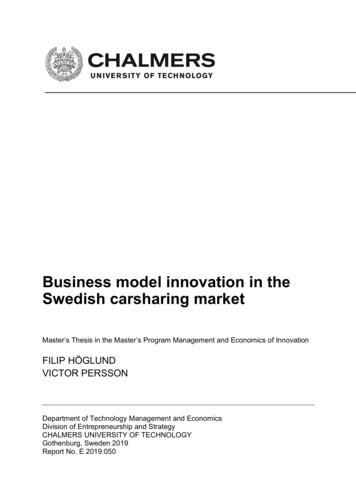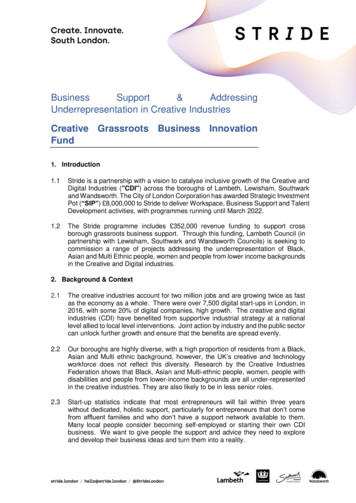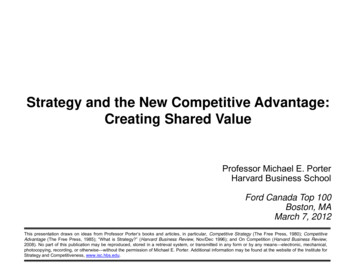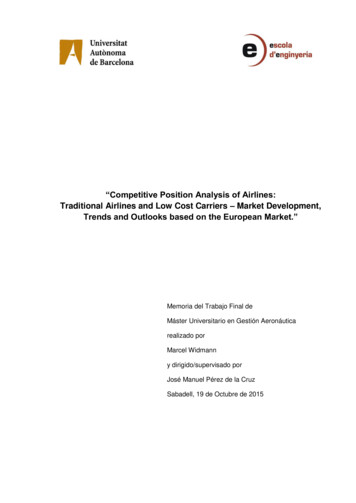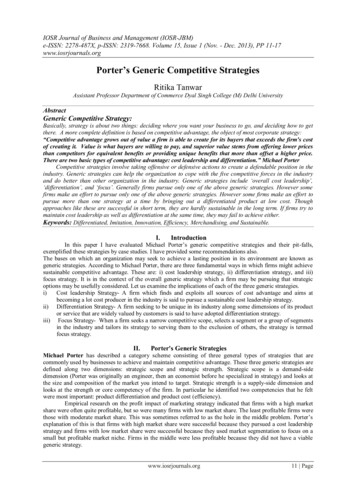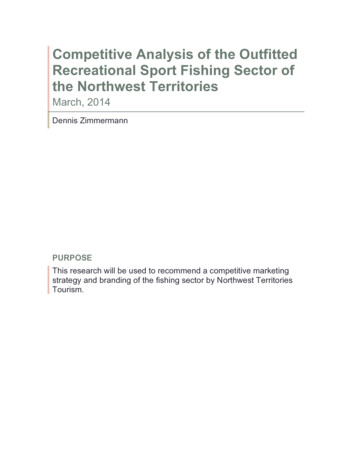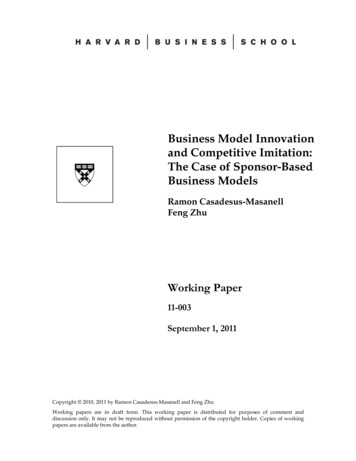
Transcription
Business Model Innovationand Competitive Imitation:The Case of Sponsor-BasedBusiness ModelsRamon Casadesus-MasanellFeng ZhuWorking Paper11-003September 1, 2011Copyright 2010, 2011 by Ramon Casadesus-Masanell and Feng ZhuWorking papers are in draft form. This working paper is distributed for purposes of comment anddiscussion only. It may not be reproduced without permission of the copyright holder. Copies of workingpapers are available from the author.
Business Model Innovation and Competitive Imitation:The Case of Sponsor-Based Business Models Ramon Casadesus-MasanellProfessorHarvard Business SchoolBoston, MA 02163Phone: 1 (617) 496-0176Email: casadesus@gmail.comFeng ZhuAssistant ProfessorMarshall School of BusinessUniversity of Southern CaliforniaLos Angeles, CA 90089-0808Phone: 1 (213) 740-8469Email: fzhu@marshall.usc.eduSeptember 1, 2011 We thank Paul Adler, Ana Leticia Gonzalez-Palomares, Joan Enric Ricart, and Monic Sun for helpfuldiscussions. Casadesus-Masanell thanks the HBS Division of Research and the SP-SP Center at IESEBusiness School.
Business Model Innovation and Competitive Imitation:The Case of Sponsor-Based Business ModelsAbstractWe study sponsor-based business model innovations where a firm monetizes its productthrough sponsors rather than setting prices to its customer base. We analyze strategicinteractions between an innovative entrant and an incumbent where the incumbentmay imitate the entrant’s business model innovation once it is revealed. We find thatan entrant needs to strategically choose whether to reveal its innovation by competingthrough the new business model, or conceal it by adopting a traditional business model.We show that the value of business model innovation may be so substantial that anincumbent may prefer to compete in a duopoly rather than to remain a monopolist.Key words: business model innovation; imitation; sponsor-based business model; strategic revelation; strategic concealment
1Business Model Innovation and Competitive ImitationINTRODUCTIONSchumpeter (1934) distinguishes between five types of innovations: new products, new methods of production, new sources of supply, exploitation of new markets, and new ways to organize business. Much of the literature so far has focused on the first two types of innovation(e.g., Shan, Walker, and Kogut 1994; Banbury and Mitchell 1995; Eisenhardt and Tabrizi1995; Schroeder 2006; Katila and Chen 2008; Leiblein and Madsen 2009; Roberts 1999; Adnerand Kapoor 2010; Leiponen and Helfat 2010; Zhou and Wu 2010). Our study focuses on thelast type of innovation, often referred to as business model innovation today. Business modelinnovation has become increasingly important both in academic literature and in practicegiven the increasing number of opportunities for business model configurations enabled bytechnological progress, new customer preferences, and deregulation.At root, business model innovation refers to the search for new logics of the firm, new waysto create and capture value for its stakeholders, and focuses primarily on finding new ways togenerate revenues and define value propositions for customers, suppliers, and partners (e.g.,Amit and Zott 2001; Magretta 2002; Zott and Amit 2007, 2008; Baden-Fuller et al. 2008;Casadesus-Masanell and Ricart 2010; Gambardella and McGahan 2010; Teece 2010). As aresult, business model innovation often affects the whole enterprise (Amit and Zott 2001).New entrants in a wide array of industries have demonstrated time and again that innovative business models can provide the basis for sustainable business success, even incompetitive settings with well-established incumbents. But just as product and process innovations are hard to protect, business model innovations can be imitated: British Airways(BA) launched Go, a copycat of Ryanair’s no-frills model, to compete against Europeanlow-cost airlines; Recoletos, one of the largest Spanish media groups, launched Qué!—an adsponsored free newspaper—in 2005 to fight the entry of similar titles such as Metro Spain;and in 2007, CBS Interactive copied Hulu’s media streaming business model.These empirical observations suggest that incumbents often learn about new businessmodels from entrants and respond by incorporating these innovations (in full or in part)
2Business Model Innovation and Competitive Imitationinto their own businesses. The possibility of competitive imitation, in turn, suggests thatentrants need to strategically choose whether to reveal their ideas by competing through thenew business model or, instead, to conceal them by adopting a traditional, established logicof value creation and value capture.While a few theoretical studies have created frameworks to examine competitive dynamics among firms employing different business models (e.g., Lin, Ke, and Whinston 2008;Casadesus-Masanell and Zhu 2010), these frameworks do not capture the role of innovationand competitive imitation in firms’ choices of business models. In this paper, we examine thedesirability or lack thereof of business model innovations when such innovations cannot beprotected and, thus, competitive imitation is possible. Specifically, we ask: under what circumstances will an entrant benefit from adopting a new business model when the innovationmay be imitated by an incumbent?Given the diversity of business models currently employed by companies in all sortsof industries, we must constrain the scope of our undertaking by studying—from amongthe many that exist, could exist—an important class of business model innovations. Wefocus here on business model innovations that allow a firm to monetize its product throughsponsors rather than by setting prices directly to its customer base. We refer to this class ofinnovations as sponsor-based business model innovations. To illustrate, consider the followingexamples: Publishing houses traditionally earn their revenues by selling books to readers at positive prices. Alternatively, the publisher could include ads intertwined with the book’stext and monetize this content by charging advertisers. In the extreme, the publishinghouse could give the books away for free and make money through ads only. Implementing such a scheme would be relatively easy for ebooks, as the ads could changeover time, just as they do in news websites. The traditional way for porn websites to monetize their content is by charging prices tosurfers. However, some sites are currently competing with a business model whereby
3Business Model Innovation and Competitive Imitationsurfers can obtain free porn if they help solve a few “captchas” to create new, legitimateemail accounts.1 The free email accounts are often worth more to spammers than thebandwidth porn surfers consume downloading videos and images, and the porn sitecan monetize them by selling these email accounts to spammers. The traditional way ski resorts monetize their offering is by charging skiers positiveprices for access to the slopes. With the growth of timeshare apartments close to theslopes,2 ski resorts are increasingly partnering with real estate firms in a business modelwhere skiers are offered free access to the slopes in exchange for enduring several hourscondominium timeshare sales-pitches. In this new scheme, the ski resort monetizesaccess to the slopes through revenues obtained from the real estate company insteadof prices paid by the skiers.These three examples are instances of the general class of situations that we study. Specifically, there is a traditional business model that involves monetizing the product throughprices charged to consumers (for books; for porn; for access to the slopes), but an innovatorhas found a new way to monetize the offering by giving it away to customers and obtainingrevenue from some sponsors. To persuade sponsors to pay, a firm needs its consumers toprovide something to the sponsors in return. Consumers often derive less utility from thefirm’s product or service as a result: indeed, in the above examples the customer suffers areduction in the quality of the good or service, and thus an impoverished consumption experience (readers must be exposed to advertisements; porn surfers must solve some captchas;skiers must sit and listen about timeshare for a number of hours).We choose to focus our study on sponsor-based business model innovations for three reasons. First, such innovations appear to be increasingly prevalent in today’s economy. For1Captchas are scrambled text boxes that many websites use to block bots. For example, Gmail usescaptchas on its account creation page to prevent automatized creation of Gmail accounts which would laterbe used to send spam.2Timeshare is a form of ownership of real estate (condominiums generally) whereby multiple parties holdrights to use the property, and each sharer is allotted a period of time (typically one week, and almost alwaysthe same time every year) in which they may use the property.
4Business Model Innovation and Competitive Imitationexample, many companies choose to finance themselves using ad revenues and offer theirproducts or services free to consumers. Such products and services today range from newspapers to software applications, from television programs to online search engines. Theincreasing popularity of sponsor-based business models has been partly fueled by opportunities granted by Internet technologies which allow much improved targeting of advertisementsand promotions as well as improved opportunities for direct interaction between firms andconsumers.Second, while many business model innovations that are to be adopted require full reconfigurations to a firm’s activity system, sponsor-based business model innovations aregenerally not overly burdensome. For example, it is easier for the New York Times to offera free, ad-sponsored newspaper than for Ethan Allen to operate like IKEA or for Avis toreinvent itself into a Zipcar. The implication is that sponsor-based business model innovations seem particularly easy to imitate. Since the purpose of our study is to analyze theeffects of potential imitation on a firm’s incentives for business model innovation, the caseof sponsor-based business models is most relevant.Third, although the notion of sponsor-based business model is well-known in sectors ofthe media industry, its penetration into other arenas has been a gradual process, as successful implementation of this business model type is not always obvious. For example, whilethe modern magazine industry originated in the mid-17th century, magazines began usingadvertisements as a means of financial support only late the 19th century.3 Similarly, European no-frills air service providers (such as Ryanair) earn a large share of their revenuesnot from ticket prices but from such ancillary sources as subsidies from secondary airportsor payments from bus companies taking passengers from those airports to city centers. Obviously, such revenue sources had been available to traditional flag carriers before the entryof low-cost airlines. Without a doubt, sponsor-based business models will become feasible inan ever-increasing number of industries.3Source: http://www.answers.com/topic/magazine, accessed May 2010.
5Business Model Innovation and Competitive ImitationSetup and main resultsOur study offers the first formal model of business model innovation in a game-theoreticframework. We focus on sponsor-based business model innovation and provide a comprehensive analysis of strategic interactions between an innovative entrant and an incumbentwhere their choices of business models are endogenously determined, and where the incumbent may imitate an entrant’s innovation once it is revealed.We analyze a three-stage game with two firms, an entrant and an incumbent, offeringvertically differentiated products. In the first stage, the entrant chooses the business modelthrough which it intends to compete: it can either compete through the traditional businessmodel (charging a price to customers for the product) or innovate by adopting a sponsorbased business model (charging zero price and monetizing the customer base in ways thataffect product quality negatively—as noted above). Prior to entry, the incumbent operatesthe traditional model and is unaware of the innovation. For simplicity, we assume that firmsface no capacity constraints.In the second stage, the incumbent observes the entrant’s business model and chooses itsown in response. If the entrant chooses the traditional business model, then the incumbentdoes not learn that there is an alternative way to compete and it may only respond with aversion of the traditional business model (for example, it may introduce several products allbased on the traditional model). However, if the entrant chooses the new business model,the incumbent can learn the innovation and may choose to imitate it, in full or in part.In the third stage, firms make their tactical choices about how they will compete withintheir choices of business model. We use the expression monetization intensity to refer tothe size of the cost imposed to customers in exchange for the free product. In the examplesabove, monetization intensity corresponds to the number of ads in the book, to the numberof captchas to be solved for access to free porn, and to the number of hours that skiers mustlisten to promoters of timeshare condominiums. Obviously, the stronger is the monetizationintensity, the larger is the revenue per customer that the firm derives from the sponsors.
6Business Model Innovation and Competitive ImitationHowever, as monetization intensity grows, product quality (and consumers’ willingness toadopt) deteriorates. In this stage, the entrant chooses price if it entered with the traditionalbusiness model, or monetization intensity if it entered with the new business model. Theincumbent chooses price and/or monetization intensity, depending on its business model andthe entrant’s choice.Our a
September 1, 2011. Business Model Innovation and Competitive Imitation: The Case of Sponsor-Based Business Models. Ramon Casadesus-Masanell Professor Harvard Business School Boston, MA 02163 Phone: 1 (617) 496-0176 Email: casadesus@gmail.com Feng Zhu Assistant Professor Marshall School of Business University of Southern California Los Angeles, CA .
